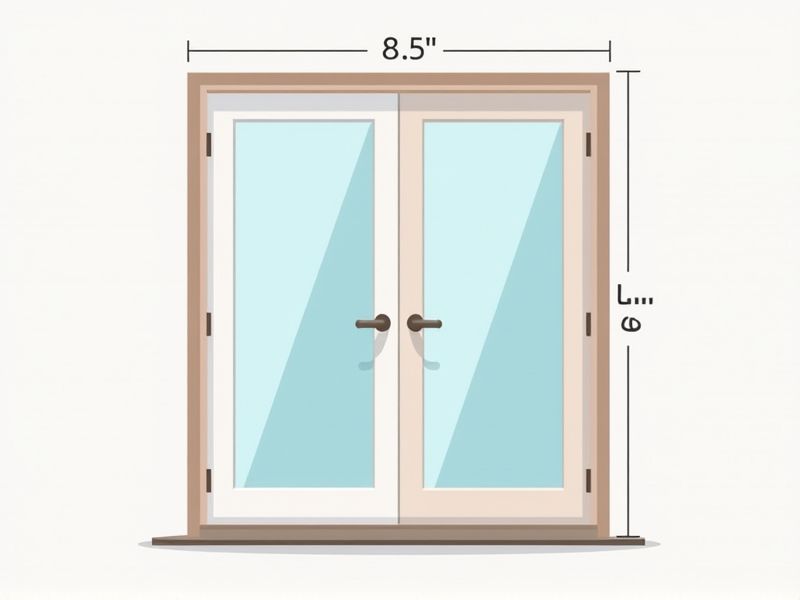
When planning for a patio door, knowing the standard dimensions helps ensure an easier installation and better fit for your space. The most common standard width for a two-panel sliding patio door is 60 inches, 72 inches, or 96 inches, while the typical height is either 80 inches or 96 inches. However, some styles and manufacturers offer three- or four-panel options, which can be wider to accommodate larger openings. Always measure your space carefully and check manufacturer specifications, as custom sizing may also be available if your opening does not match typical standards.
Typical Width: 60 To 72 Inches
Patio door widths typically range from 60 to 72 inches, providing ample space for movement and accessibility. Most models also offer a height of 80 inches, ensuring a standard fit for most homes. This size accommodates various design preferences, allowing for both sliding and French door styles to enhance aesthetic appeal. When selecting, consider materials such as vinyl, wood, or fiberglass for durability and energy efficiency.
Standard Height: 80 Inches
The standard height for patio doors is 80 inches, which ensures compatibility with most residential designs while providing ease of access. This height accommodates various frame styles, allowing for seamless transitions between indoor and outdoor spaces. The standard width often ranges from 60 to 72 inches, enhancing light entry and panoramic views. Choosing the right patio door at these dimensions can significantly improve your living space's overall aesthetics and functionality.
French Doors Double Opening
French patio doors typically consist of two hinged panels that swing open, providing an elegant entryway and maximizing natural light. Standard sizes for these double-opening doors range from 60 inches to 72 inches in width and up to 80 inches in height, making them ideal for enhancing the aesthetic appeal of your home. Energy efficiency is a key factor, with many modern French doors featuring double or triple-pane glass to reduce heating and cooling costs, with U-factors often ranging from 0.20 to 0.35. If you're considering installation, ensure proper framing and threshold measurement to maintain optimal performance and security.
Sliding Doors Space-Saving
A standard patio door typically features sliding doors that offer a space-saving solution, making them ideal for small patios or tight indoor areas where traditional swinging doors would be impractical. These doors often come in varying widths, usually ranging from 60 to 72 inches, allowing for easy access while maximizing natural light. With a crucial thermal performance rating of at least R-3, modern sliding patio doors enhance energy efficiency by minimizing heat transfer and maintaining comfortable indoor temperatures. You can also choose from different frame materials like vinyl, wood, or aluminum, each offering unique benefits such as durability and aesthetic appeal.
Customizable Options
Patio doors now offer customizable options to enhance your home's aesthetic and functionality. With choices in frame materials such as vinyl, aluminum, and wood, you can tailor the look to match your personal style. Stylish glass options, including double or triple-pane for energy efficiency, can significantly impact your utility bills, often reducing them by up to 30%. Choose from diverse operating styles like sliding, folding, or hinged doors, ensuring your entryway seamlessly integrates with your living space.
Ada Compliance For Accessibility
Patio doors designed for ADA compliance must feature a minimum clear opening width of 32 inches to accommodate wheelchair access. The threshold height should not exceed 1/2 inch to prevent tripping hazards, ensuring safe passage for all users. Lever-style handles are recommended, as they require less force to operate--ideally, no more than 5 pounds of pressure. To enhance visibility and ease of use, the contrasting colors between the door and surrounding wall are essential, helping users identify the door quickly.
Insulation And Energy Efficiency
Patio doors are essential for energy efficiency and insulation in homes, often featuring double or triple-pane glass to minimize heat loss. With a U-factor of 0.30 or lower, these doors provide superior thermal performance, ensuring your living space stays comfortable year-round. Energy Star certification is a key indicator, as it signifies compliance with strict energy efficiency guidelines, saving you up to 15% on energy bills. Selecting high-quality frame materials, such as vinyl or fiberglass, further enhances insulation properties, reducing noise pollution and drafts.
Frame Materials Like Vinyl Or Aluminum
Patio door frames are predominantly made from two main materials: vinyl and aluminum, each offering distinct advantages. Vinyl frames provide superior energy efficiency with insulation values often exceeding R-5, making them ideal for maintaining indoor temperatures. In contrast, aluminum frames deliver exceptional durability and resistance to warping, making them suitable for regions with extreme weather conditions. When selecting your patio door, consider the longevity and maintenance requirements of each material to ensure your investment lasts for years.
Pane Options For Added Security
When selecting a patio door, consider the security benefits of laminated and tempered glass panes, which enhance resistance to breakage. Laminated glass features an interlayer that holds shards together upon impact, increasing safety for your home. Tempered glass, on the other hand, undergoes a heating and cooling process that makes it more durable and less prone to shattering. By incorporating these pane options, you can significantly improve the security of your patio door, ensuring peace of mind for you and your family.
Weather Resistance Features
Weather-resistant patio doors typically feature multiple layers of treatment, ensuring durability against elements like rain, wind, and extreme temperatures. When selecting a patio door, look for a minimum of energy efficiency ratings such as U-Factor of 0.30 or lower, indicating strong insulation capabilities. Enhanced weatherstripping around the frame can also prevent drafts and moisture infiltration, providing essential protection for your indoor environment. Materials like fiberglass or vinyl are recommended for their high resistance to corrosion, maintaining functionality and aesthetics over time.
